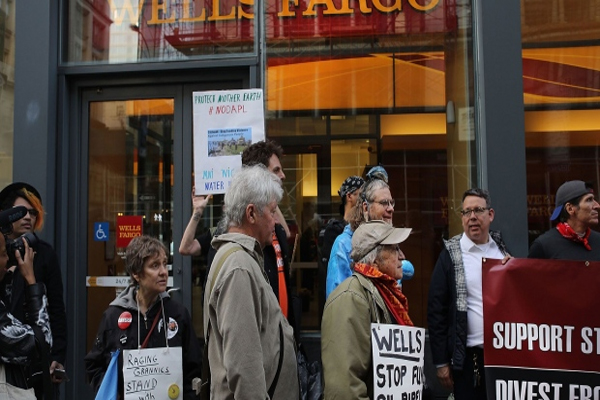
Max Abelson and Hannah Levitt, Bloomberg News
NEW YORK
EnergiesNet.com 03 23 2022
One year after Wells Fargo & Co. became one of the last big U.S. banks to make a net-zero promise, essentially marking its enormous oil and gas loan business for extinction, the bankers who dole out billions of dollars to fossil fuel aren’t panicking.
The specialists in oil and gas have worked through a streak of money-burning years capped by a brutal pandemic. Now the hydrocarbon business is roaring back, and Wells Fargo’s lenders sit right at the top. No one in the world put together more fossil fuel loans last year as bookrunner, according to data Bloomberg compiled: The bank’s 2021 tally in the sector topped $28 billion; it’s racked up more than $188 billion in oil and gas loans since late 2015, when the landmark Paris Agreement was adopted. That sum is more than the market capitalization of BP, Marathon Petroleum, and Valero Energy—combined.
There are good reasons for the leaders in fossil finance to be anxious. Start with the bank’s net-zero goal: Wells has joined more than 100 financial institutions with midcentury deadlines for axing greenhouse gas. Few bankers like to be in a line of work practically marked for elimination. Even if you happen to distrust corporate pledges, the explosion of environmental, social, and governance considerations into a multitrilliondollar industry puts pressure on those in the business of funding oil, gas, and coal.
But Wells bankers are playing the long game. “There’s this idea or dynamic that it’s a light switch,” says Scott Warrender, who runs the energy and power team. The green revolution? “Our view — and in reality — it will play out over a much longer time frame.”
Wells executives won’t stop making hydrocarbon loans when the rest of us are consuming so much of it, according to interviews with 10 current and former people there. Few veterans of this business are quite sure where it goes from here. Their attitude toward the crisis of climate change veers between pragmatism and, in the case of one former executive, disdain.
It all adds up to a high-stakes moment for the energy industry, the warming world, and Wall Street, especially for a bank that Chief Executive Officer Charlie Scharf is trying to turn around after years of scandals. Since access to capital is so important to the fossil fuel industry, which plows through money, the moral and financial calculations of bankers like those at Wells will play a key role in the future of the climate.
Until the economy and society both evolve, Warrender says, “our view is we need to bank the broad energy sector in all of its forms.” Over decades as an energy banker, he’s watched the hydrocarbon industry dive into busts and then climb back into big-money booms. He’s survived the tumult and learned to stick it out through the endgame, he told a journalist over a decade ago, back when he likened his job as an energy banker to his pastime of amateur boxing. Today, he says, his hobby has switched to cycling, but his focus on energy is unchanged.
“That’s going to be what’s interesting,” says Derek Detring, who had a stint eight years ago as a Wells energy banker before he started a firm advising the energy industry. “Now that we’re making money again, will investors stay away?” As the long-suffering industry returns to being lucrative, he says, “it will be harder for them to leave.”
Indeed, oil prices soared after the invasion of Ukraine and moves by the U.S. and U.K. to ban Russian oil. Energy executives and their bankers are used to volatility. Wells Fargo’s fossil fuel lending has stayed at the top of the industry even as annual totals bounced around—from $23.7 billion in 2016, up to $48.3 billion in 2018, and then back down to $28.7 billion last year.
Historically, bankers haven’t been under much pressure from shareholders to move faster on climate. But that could change. Last year, ahead of the United Nations climate conference, Wells joined the Glasgow Financial Alliance for Net Zero, a group of banks and fund managers representing $130 trillion in assets. (Michael Bloomberg, the owner and founder of Bloomberg LP, is co-chair of the alliance.) The big banks, in addition to pledging to zero out emissions, have agreed to eventually begin accounting for the carbon in their vast portfolios. Coming up with measurements for “financed emissions” will be hotly contested, and activists will be watching. In December the investor group Interfaith Center on Corporate Responsibility asked Wells and other banks to adopt a policy by the end of 2022 to ensure that lending and underwriting don’t contribute to new fossil fuel development.
For now, though, a Wall Street giant can go green and underwrite the clean-energy future while also doing deals on gas pipelines and oil fields. Wells was just ahead of JPMorgan Chase & Co. last year as the bookrunner on syndicated loans, which means being the bank in charge when several are involved. Looking at loans gives a good sense of how fossil fuel companies finance themselves, but they also work with Wall Street to issue bonds. Wells wasn’t the biggest in that space last year—the $7.7 billion it managed was about half of JPMorgan’s $15.8 billion.
“We’ve been a leading financial partner to traditional energy companies, such as oil and gas producers and electric utilities, as well as the emerging renewables business, for many years,” said a Wells spokesperson. “We will continue to support our clients in this industry as they provide the fuel that powers society today, and as they respond to the evolving market.”
None of the bank’s recent oil and gas lending deals have been bigger than the $5 billion revolving loan it led in 2018 for Energy Transfer LP, whose Dakota Access Pipeline is at the heart of the battle between the oil industry and the Standing Rock Sioux Tribe. Billionaire Kelcy Warren, the chairman of the Dallas-based pipeline operator, has a relationship with Wells that stretches back decades. Not long before the loan, advisory group Institutional Shareholder Services Inc. recommended that Wells investors support a resolution requiring policies to help protect Indigenous groups. Protesters made their way in 2017 to the California home of Tim Sloan, then the boss of the bank, and set up an inflatable pipeline.
That didn’t scare Wells out of the business. Its most significant syndicated fossil fuel loan last year was a $3 billion deal with Enterprise Products Partners LP. The Houston pipeline owner agreed in January to buy Navitas Midstream Partners and its 1,750 miles of pipeline in the Permian Basin for $3.25 billion in cash.
The story of energy lending isn’t just about the future of climate — it’s also about consolidation turning dozens of banks into just a few. Wells ended up a giant in fossil loans after a string of acquisitions. Tim Murray, a top Wells energy executive until his 2005 departure, harbors views that buck the scientific consensus. “The Arctic is not melting, it’s actually growing,” says Murray, who was later a Guggenheim Partners executive and adviser to the Texas oil industry. In reality, the Arctic is warming far faster than the rest of the world.
Dan Pickering, a veteran of the Texas energy-banking industry, has heard Wall Street change its tune on the environment. “In the swashbuckling oil and gas days, the answer would have been, ‘Yeah, I loan to the oil and gas industry, so what? We make a lot of money doing it, and that’s what we’re supposed to do.’ ” Now, he says, the answer is gentler. For the banks that are sticking around, facing fewer competitors, “maybe they’re laughing all the way to the bank.”
There’s money to be made on both sides of the energy transition—and sometimes the same bankers are on opposing ends. Last year, for example, Wells formed an energy-transition team under Warrender to focus on developing renewables and charging infrastructure for electric vehicles.
About six years ago the team looked different than it does now. Herb Rakebrand worked on market strategy and project development with the Wells energy team, where the engineer and Grateful Dead fan felt like an outsider among the Type A bankers. Rakebrand said the bankers considered him a nerd.
David Marcell, who worked on acquisitions and divestitures on the team in this era, had a slightly different view of their personalities. “What’s the right word I want to use? They weren’t the belt-and-suspender kind of guys,” he says about his colleagues. “They were the guys that worked hard and did the best they could for clients.”
Tyler Harris, a Wells client when he was chief financial officer of an exploration and production firm, watched banks rush into the space as if nothing could go wrong. The adage he remembers about oil and gas lending: “No bank has ever lost money doing this.” The wild competition allowed companies to pit lenders against each other, remembers Harris, who’s now an executive at Moriah Energy Investments LLC. “People just got lazy,” he says. “They got complacent.”
OPEC helped end those easy times around Thanksgiving 2014 by refusing to cut production to ease an oil glut. One energy veteran remembers that holiday this way: Normally it’s the Dallas Cowboys losing that causes him to go face down in his pumpkin pie. Prices tanked, beginning a long slump for the industry and its bankers.
In some ways, their hands were tied. If you borrow to buy a pickup truck and default, the bank can send someone to your driveway to repossess it. Energy assets are more finicky. “It’s not like you poke a hole in the ground and the oil comes out and it’s all sunshine and roses,” Harris says. Instead, lenders decided to wait for prices to rebound. “They punted,” he says. “You need a waiver to get you through another six months? Fine.”
Years of bad returns may have opened the door for some banks to give up on oil and gas. BNP Paribas SA, the French bank that sold its energy-lending unit to Wells in 2012, announced five years later that it would stop doing business with companies whose main business was exploring, producing, or distributing shale gas or oil from tar sands.
It was easier for Wall Street to sour on the energy business when they were losing money on loans, says Buddy Clark, co-chair of energy at the law firm Haynes Boone in Houston. “But if prices go to $100 a barrel, and money is being printed by these oil companies, I cannot imagine but that the banks will be back.” It all suggests a pattern: “Prices are starting to come back, so the cycle begins anew.” In other words, he says, just because ESG appears to be “front and center” doesn’t mean it will be forever. Wells Fargo has pledged to commit $500 billion in sustainable finance this decade, and JPMorgan’s green target is $1 trillion.
The Sierra Club’s Adele Shraiman is working on the environmental group’s Fossil Free Finance campaign to make sure the ESG era lasts. “Wall Street has the power to change the direction of our energy future based on where they choose to put their money,” she says. “We aren’t talking about turning off the tap overnight.”
The pressure on the banks is growing by the week. After taking on Spotify Technology SA over Covid-19 disinformation, the musician Neil Young called on fellow baby boomers to “ditch the companies contributing to the mass fossil fuel destruction of Earth.” He encouraged fans to withdraw savings from JPMorgan, Citigroup Inc., Bank of America Corp., and Wells.
Yet the finance and fossil fuel businesses may be entering a particularly happy chapter in their relationship. After years of annoying Wall Street by putting expansion over investor returns, shale explorers have pledged to give record cash flows back to shareholders. That’s lured back investors just as the price of oil has jumped.
Murray, the former Wells executive, is optimistic about the future of energy lending. “I think eventually the public and Wall Street will come to that realization that we already know,” he says. “You guys are going to need us for a long time.”
bloomberg.com 21 03 2022











